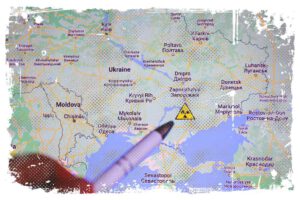Let me tell you a story. From 1939 to 1945, the Third Reich spread a network of camps across the lands it conquered in Europe. They wanted to imprison people who they deemed „useless” or hostile. As time went on, these camps transformed from detention centers into extermination camps, specifically designed to eradicate populations seen as troublesome by the Nazi Germans.
The switch to mass extermination started around the end of 1942, when German authorities settled on the „final solution to the Jewish question”.
I must mention, even before this, life in these camps was harsh. The brutal guards and intense labor caused a high death rate. Most camps remained functional until 1945. Some ceased operations due to the Allied invasion, while others were hastily „evacuated” at war’s end.

These „evacuations” often meant the death of prisoners during grueling „death marches” to other camps, as the Nazis attempted to cover their tracks.
↳ PRO TIP: Do you like traveling? Then before you buy any ticket or book an attraction, check if it's available in this worldwide Viator Database. You may save a lot of money and time. No need to thank me :)
The Misinterpretation – Polish Concentration Camps
I think it’s worth saying that there’s a common misnomer: „Polish concentration camps”. This term pops up in media, publications, and even historical studies. It refers to Nazi concentration camps located within 1939 Poland borders. This can misleadingly suggest that the camps were founded and managed by Poles.
Some believe this phrase is purposely used as propaganda against Poland. There are even offshoot terms like „Polish death camps” or „Polish Holocaust” (Polish Holocaust), and the German „polnische Häuser des Todes” – „Polish death houses„. Let me tell you, it’s not accurate.
Extermination Camps in Polish Lands – The Deathly List
Allow me to explain, on Polish lands (compared to today’s state), the following German extermination camps were located: Auschwitz-Birkenau, Bełżec, Gross-Rosen, Kulmhof, Majdanek, Płaszów, Sobibór, Stutthof, and Treblinka. Each has its own dark history, liberation story, and a tally of victims who perished due to the Germans’ extermination actions. We will delve into them one by one.
Based on the research, here is a table summarizing the information for each concentration camp:
| Concentration camp | Total Imprisoned People | Number of Victims Who Died |
|---|---|---|
| Auschwitz-Birkenau | 1,300,000 (estimated) | 1,110,000 (estimated) |
| Bełżec | 600,000 (estimated) | 450,000 (estimated) |
| Gross Rosen | 125,000 | 40,000 |
| Kumhof | 200,000 (estimated) | 200,000 (estimated) |
| Majdanek | 360,000 (estimated) | 230,000 (estimated) |
| Plaszow | 150,000 (estimated) | 80,000 (estimated) |
| Sobibór | 250,000 (estimated) | 250,000 (estimated) |
| Stutthof | 120,000 (estimated) | 80,000 (estimated) |
| Treblinka | 920,000 (estimated) | 710,000 (estimated) |
Please note: the numbers provided are estimates and may not be exact due to the destruction of records and varying accounts from different sources. These numbers represent the scale of the atrocities committed in these concentration camps during the Holocaust.
Auschwitz-Birkenau Concentration Camp

If you want to know how Auschwitz-Birkenau began, it was on Heinrich Himmler’s order, on April 27, 1940. The construction of a concentration camp started on the outskirts of Oświęcim, in an area that was once military barracks.
The existing structures were repurposed. A month after the camp was established, the first group of prisoners arrived. They were thirty criminals from Germany who later assumed supervisory roles over other prisoners.
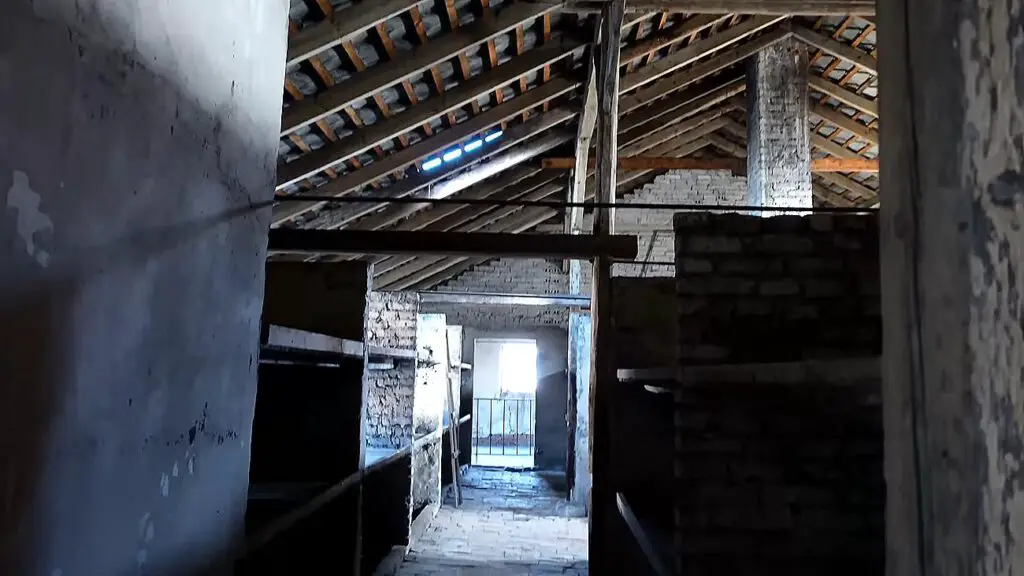
The Auschwitz camp system started to evolve from there. They brought in prisoners from different parts of Europe, captured during the Wehrmacht’s military conquests. As the complex grew, German authorities displaced people from nearby villages.
Gradually, fences went up, and guard towers appeared. Escape seemed near impossible, but there were still those brave enough to attempt it. In October 1941, once again on Himmler’s orders, the creation of a camp branch in nearby Birkenau commenced.
Birkenau was initially meant to isolate Soviet prisoners. But over time, it morphed into a mass graveyard, executing the plans laid out by the „Final Solution of the Jewish Question”. In Auschwitz, they began testing Zyklon B on prisoners, which they would later use on a larger scale.
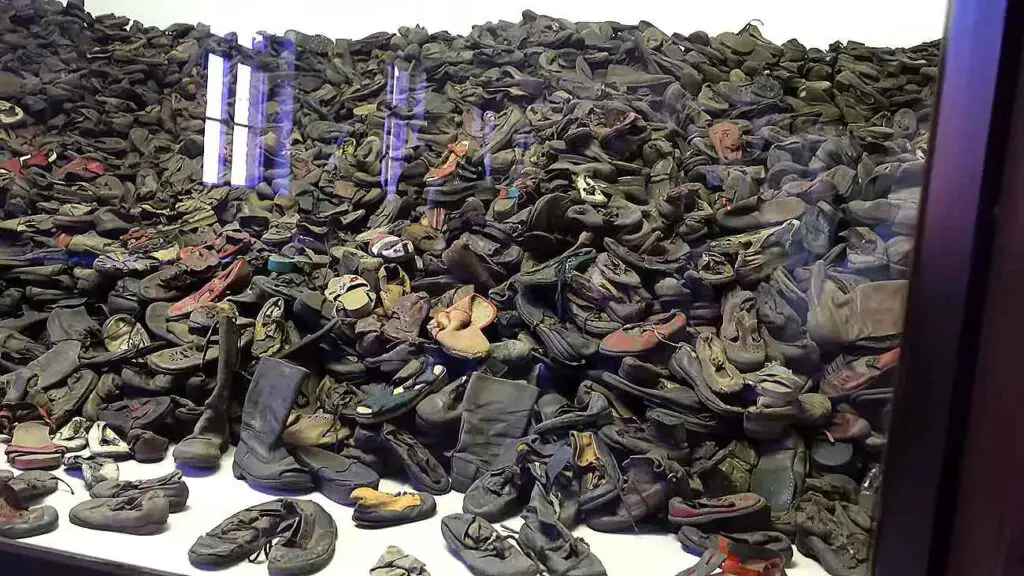
As operations started following the Wannsee Conference, the Auschwitz-Birkenau complex transformed into a German system of mass prisoner execution. In the two main branches of the camp, four gas chambers supported by crematoria were built. The camps’ capacity was continually increased, fuellin the German death machine.
The Unveiling of Auschwitz-Birkenau
When the Red Army advanced, the Germans realized that the secrets of the Auschwitz-Birkenau complex wouldn’t remain hidden for long. So, in 1944, they begn to hastily evacuate the camp and erase any evidence of the genocide committed there. By January 1945, thousands of prisoners were moved to other camp units that weren’t under threat from the Soviet offensive.a

During the last two days of Auschwitz’s operation, nearly 60 000 people were marched out of the camp. Many didn’t survive the harsh conditions of the march. On January 9, Red Army soldiers entered the camp, liberating the remaining prisoners.
These prisoners were marked for death, but the Germans ran out of time. Sadly, despite immediate aid, many of them didn’t survive the following weeks, with only a few living to see the end of the war.
Victims of Auschwitz-Birkenau – Shocking Numbers –
I think it’s worth saying that the staggering scale of German atrocities is best reflected in Auschwitz-Birkenau’s statistics. We can’t be sure about the actual number of victims because the Germans largely destroyed their records, and even those weren’t entirely comprehensive.

Post-war research has also suffered from numerous distortions. However, it’s believed that the camp claimed around 1,110,000 lives out of the 1,300,000 people who passed through its gates.

Concentration Camp in Bełżec – House of Horrors
Bełżec had its start as a labor camp in 1940. Here, Poles and Jews were most often imprisoned. In August 1941, a camp for liquidating Soviet prisoners of war sent from the Eastern Front was established. By November 1941, construction of an immediate extermination center had begun.

Bełżec – Building a Death Factory
By February 1942, the 6-hectare area had become a large complex ready to carry out German atrocities. The camp was divided into two main parts. The first part served as the unloading area (railway ramp) and accommodation. The second part was a place of execution, complete with a gas chamber and graves.

The prisoners were under the watchful eyes of 30 SS men and nearly 200 guards, commanded by Christian Wirth and later Gotlieb Hering. Both of them answered to Otto Globocnik, who was in charge of Aktion Reinhard. This operation involved the mass extermination of Jews in the camps of Sobibór, Treblinka, and Bełżec. The first mass murder using gas took place in February 1942.
The Arrival of Innocents – Bełżec’s Deception
Starting from March, transports of Jews, usually entire families, began to arrive. The camp was set up in such a way that the prisoners didn’t realize they were being led to their deaths. Transports kept coming until November 1942.

In December, the camp stopped its death machines. At that time, they began a massive operation to burn the bodies in the mass graves. By the end of June 1943, Bełżec had ceased to function entirely.

The Erasure of Bełżec
Following the cessation of its operation, the Germans methodically liquidated Bełżec, dismantling machinery and demolishing buildings.

They reforested the area, hiding the site’s grim past beneath a layer of nature. The remaining prisoners were dispatched to the mass extermination center at Sobibór.
Bełżec – An Unthinkable Number

The Commission for German War Crimes in Occupied Poland estimated the number of victims at Bełżec. Their findings put the number of those murdered at a staggering 450.000 people.
Gross-Rosen Concentration Camp
Gross-Rosen camp was situated in the Rogoźnica region as an extension of the Sachsenhausen camp. In the summer of 1940, they started building the first camp rooms, and by August, the initial transport of prisoners had arrived. On May 1, 1941, Gross-Rosen declared independence from Sachsenhausen.

The camp was overseen by commandants Arthur Rödl, Wilhelm Gideon, and Johannes Hassebroek. Primarily, Gross-Rosen functioned as a labor camp for prisoners sent from various locations.
Expansion of Gross-Rosen – A Growing Network
In 1942, they began constructing a vast network of satellite camps, all subordinate to Gross-Rosen. At the same time, prisoners started coming directly from prisons. They also sent 'educational’ prisoners here, who were to serve relatively short sentences. A spike in transports occurred particularly during 1944-45.

While the extermination of prisoners wasn’t as drastic as in the previously discussed extermination camps, the Germans still committed mass murders at the Rogoźnica camp. Over time, those marked for liquidation were sent to other camps, including Auschwitz-Birkenau.
Life and Death in Gross-Rosen
In 1944 and 1945, Gross-Rosen was overwhelmed with an influx of prisoners. This was due to the advancing Red Army, as prisoners were relocated from the eastern territories under threat of liberation.

The camp was characterized by its forced labor system, with prisoners working for the occupant. There were quarries and industrial factories within the camp, including „Siemens und Halske” and „Blaupunkt”.
The Final Days of Gross-Rosen
The liquidation of Gross-Rosen started in early 1945. In February, they organized mass „death marches” from the camp, moving prisoners to other facilities. These treks, often under brutal conditions, were practically death sentences.

On February 14, 1945, Red Army soldiers entered the camp, bringing an end to its reign of terror.
Victims of Gross-Rosen
Around 125,000 people were incarcerated in the Gross-Rosen camp. Around 40,000 of these, succumbed to the deliberate actions of the Germans or the effects of exhaustion, diseases, and malnutrition.
Kulmhof Camp in Chełmno
Kulmhof was set up near Chelmno. Initiated in the summer of 1941, the camp’s creation was tied to plans to annihilate Jews residing in Wartheland. The first prisoner transports were recorded in December 1941.

Prisoners were typically killed on arrival using truck exhaust fumes. The mass murder of Jewish populations escalated after the Wannsee Conference, reflecting in Kulmhof’s operations. There were occasions when Gypsies were sent to the camp, with an estimated 4300 Gypsies murdered.

Kulmhof – Beyond Wartheland
It’s believed that the vicinity of Chełmno also saw the execution of people from the Zamość region, mainly children, and inhabitants of the Czech town of Lidice. In 1942, they refined their killing process for efficiency, introducing chambers built into trucks. Herbert Lange, the first camp commandant, was succeeded by Hans Bothmann.
Kulmhof’s operation was disrupted in April 1943 when both transports and executions ceased. For over a year, the camp stood outside the Nazi extermination apparatus. However, on June 26, 1944, its dark operations resumed. The second phase of activities ended on July 14, 1944, with the camp’s final closure on January 17, 1945.
Kulmhof’s Liberation – The End of Atrocities
During Kulmhof’s extermination hiatus, the Germans began to conceal evidence. This task was performed by Sonderkommando 1005, a unit formed specifically for this purpose. In July 1944, they dismantled the barracks, and no new transports were accepted.
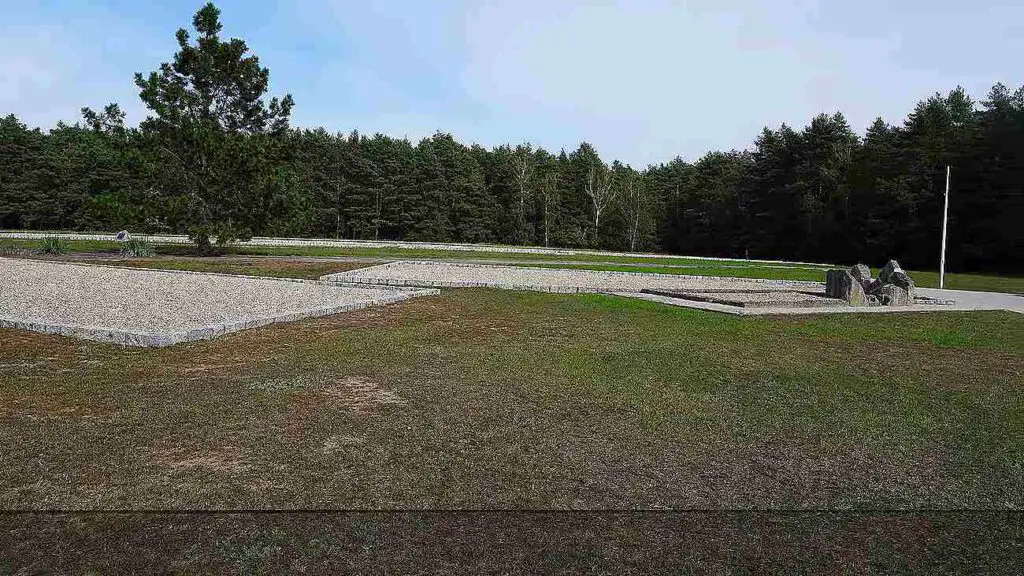
On January 17-18, 1945, dozens of workers were executed, with some victims burnt in one of the buildings. Three managed to escape.
The Red Army made its entrance on January 18, 1945. By then, Kulmhof had already ceased its operation and had been previously liquidated.
Victims of Kulmhof

The investigation conducted after the war by Judge Władysław Bednarz from the District Court in Łódź established the number of murdered at 350,000. The lowest – 152,000 victims was established at the trial in Bonn in the 1960s.
The most probable number is 200,000 murdered. The majority were Jews from Wartheland. As mentioned, Gypsies, as well as Polish and Czech poulations, were also murdered there.
Majdanek Concentration Camp
Formally established in April 1942, KL Lublin-Majdanek initially served as a camp for Soviet prisoners of war from October 1941. Its official name, until February 1943, was Kriegsgefangenlager.

The title changed to Konzentrationslager der Waffen SS Lublin thereafter. Majdanek’s operations were a blend of various forms of prisoner repression. It was a POW camp, but it also functioned as an extermination camp.
Majdanek – The Diversity and Expansion
The prisoner demographics were quite varied, with citizens from 28 countries and 54 nationalities. By the end of 1942, Majdanek was also being used for mass exterminations of the population from the Zamość region, where the Germans were carrying out deportations.

Transports of Jews from various parts of the country and abroad also landed here. Initially, over two hundred barracks were planned to accommodate the German war machine’s real transport capabilities. In 1942, the barracks count increased as the camp expanded.

An Atrocity on a Massive Scale
In total, the plans pointed to a horrifying figure of 250,000 prisoners in one camp complex. Gas chamber assembly started in August with five chambers planned. Like in Auschwitz-Birkenau, these chambers utilized deadly Cyclone B poison.
Majdanek also served as a transit camp, sending numerous transports to other camps where prisoners were forced into slave labor or murdered.
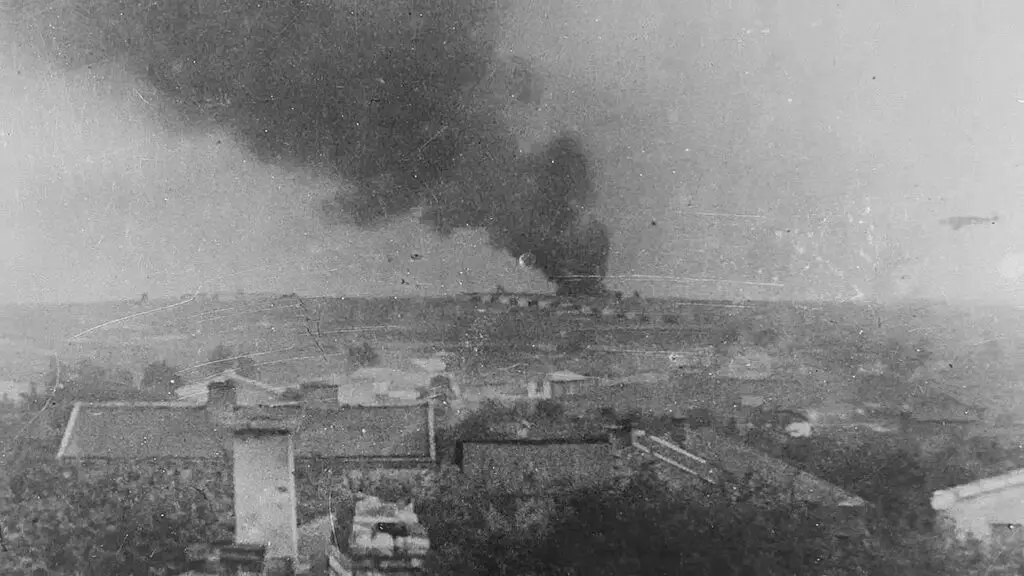
The camp commandants, who frequently changed, deserve a mention. SS-Standartenführer Karl Otto Koch was the first, followed by SS-Obersturmbannführer Max Koegel, SS-Hauptsturmführer Hermann Florstedt, SS-Obersturmbannführer Martin Weiss, and SS-Obersturmbannführer Arthur Liebehenschel.

The evacuation of Majdanek began on April 1, 1944, triggered by the Red Army’s advancing offensive. This operation lasted until July.
Liberation of Majdanek
Even though the Germans evacuated some prisoners from Majdanek in July, this marked the camp’s last operational phase. On July 23, 1944, Red Army troops entered the camp, liberating the last prisoners.

Interestingly, the Soviets later repurposed the post-German buildings to run a camp for soldiers of the Home Army and the National Armed Forces, akin to the Auschwitz camp’s branch in Jaworzno.
Majdanek’s – Number of Victims

Estimates suggest that up to 360,00 people might have been confined in the camp, with as many as more than 230,000 died. It’s clear the mortality rate was substantial. As we can see, the mortality rate was high.
We do not know how it really was, because various studies show different numbers of murdered prisoners. There are data about 360,000 killed, there are those who claim that this number did not exceed 80,000 people.
Płaszów Concentration Camp
Let’s talk about Płaszów. For the most part, this camp functioned as a labor camp. The name, Zwangsarbeitslager Plaszow bei Krakau des SS und Polizaisführers im Distrikt Krakau, reflects that. If you want a geographical idea, the camp was located near Krakow.

Come January 1944, it was designated as a concentration camp. Its primary purpose? To serve in the extermination of the local Jewish population, those sent from the Krakow and Tarnów ghettos and beyond. At the height of its operations, the camp spanned 80 hectares, and was set within two Jewish cemeteries, surrounded by electrified barbed wire.
Infrastructure and Life in Płaszów
In addition to the electrified fence, the Nazi occupiers dug a water-filled ditch as an extra barrier. The prisoners were confined in wooden barracks. I think it’s worth saying that in mid-1943, Płaszów was integrated into the structures of sub-camp branches of KL Majdanek.

It wasn’t until April 1944 that it gained autonomy. Moreover, it even spawned branches in Wieliczka and Mielec. The life of a prisoner? Brutally hard. They were forced to do grueling physical work under dire conditions.
Nazi tormentors employed sophisticated methods of torturing prisoners. Often, executions by shootings were the norm. Unlike other camps, Płaszów had no gas chambers or crematoriums. Prisoners were sent to other facilities for that.

Allow me to introduce the dark commandants of Płaszów: Horst Pilarzyk, an unnamed Müller, Amon Goth, and Kurt Schupke. By the end of 1944, the camp’s liquidation had begun.
Płaszów’s End – Liberation
In January 1945, during the final stages of the camp’s evacuation, only a handful of prisoners were left. Some were sent off to Auschwitz or Treblinka. The last prisoner transport departed on January 15, 1945. Two days later, the Red Army arrived.
Płaszów – Death Statistics

To give you some perspective, up to 150,000 people were processed through the camp. The number of people who died in the Płaszów concentration camp is not specified However, of these, up to 80,000 could have died.
At its peak, it held some 20,000 or more inmates, including hundreds of Roma (Gypsies) and Polish prisoners from the Warsaw Uprising. Thousands were killed there, mostly by shooting.
Sobibór Camp
Next on the list is Sobibór. It was one of the centers for Aktion Reinhard, which primarily aimed at the extermination of Jews. Sobibór, along with Bełżec and Treblinka, made up the trio of death camps. Under the Aktion Reinhard plan, Sobibór answered to Otto Globocnik.

The commandants in charge were Richard Thomalla, Franz Stangl, and Franz Reichleitner. I believe it is worth mentioning that Sobibór’s construction began in March 1942.
Existing Structures and Extermination
This site already had buildings that had been a labor camp since 1940. This was part of the network of labor camps in the surrounding areas.

The real game-changer, however, was the establishment of a mass extermination camp in May 1942. Initially, Sobibór was a little over 12 hectares, but it eventually grew to encompass 58.8 hectares.
It was surrounded by barbed wire, and escape was made even more treacherous by a landmine-filled strip around the camp. Guard towers manned by SS personnel, numbering about 30, protected the camp. They were backed by local Ukrainian collaborators.
Inside Sobibór
The camp had a quick division – the Vorlager with the railway ramp, and four sections of the camp. The first had residential buildings, the second a square and transit barracks, and the third gas chambers and mass graves.

The fourth section, established in 1943, was rather insignificant. I think it’s worth noting that on October 14, 1943, the prisoners staged an uprising. This marked a turning point for the camp. Despite quashing the rebellion, the Germans decided to shut down the center, which they promptly did.
Gas Chambers and Extermination
One can’t ignore the topic of prisoner extermination, chiefly via the camp’s four gas chambers. A single gassing could accommodate up to 600 people.

The camp’s first victims were Jewish workers involved in its construction. Subsequently, Sobibór became a death spot for people from the Lublin district. From November 1942 to October 1943, the camp saw Jewish transports from beyond Poland.
The End of Sobibór

The camp’s „liberation” was peculiar – it was self-liquidated by the Germans. The estimated number of victims is blurry, but it is believed that around 250,000 people, including a significant portion of Jews, met their end here.
Stutthof Concentration Camp
Let me take you back to the pre-war era. That’s when the history of Stutthof started, making it one of the longest-operating camps in Poland. German authorities wanted another concentration camp in the Free City of Danzig.

And so, in August 1939, the forests near the village of Sztutowo were cleared. I can tell that the location chosen for the camp was ideal for isolation.
The area was engulfed by water bodies, swamps, and peat bogs, making escape attempts nearly impossible. On the brink of the September campaign, the Germans arrested 1500 Poles who were shipped to the Sztutowo camp on September 2.

Building their Prison
Once there, the prisoners were primarily used for construction work. They were, in effect, building their own prison. The camp was fenced with barbed wire, and SS guards kept watch from their towers. Residential barracks were built for the prisoners to live in.

Owing to continuous expansion, by December 1944, the camp had spread over 12 hectares. Initially, Stutthof was called Zivilgefangenlager, but later it was reanmed SS-Sonderlager.
Upgraded to a Concentration Camp
It was not until February 20, 1942, that Stutthof received the status of a concentration camp. In addition, it controlled over 40 sub-camps and commandant’s offices. I think it’s worth saying that Stutthof was an extensive network of camps, with a central hub at Stutthof.
The primary commanders were SS-Hauptsturmführer Max Pauly and SS-Sturmbannführer Paul Werner Hoppe. Assisting them were adjutants SS-Obersturmführer Erach Muller, SS-Untersturmführer Walter Unger, and SS-Oberscharführer Josef Stahl.
Stutthof – The Final Days
On January 25, 1945, commandant Paul Werner Hoppe ordered the evacuation of the main camp. This order was followed through, often with no regard for the prisoners’ ability to survive the ordeal.

The „death marches” were notorious, resulting in many fatalities among those evacuated. At that time, nearly 7,000 prisoners didn’t get to the destination point. Luckily more than 2,000 managed to escape during the marches.
Not long after, people were forced onto a „death march.” The large number of women, primarily Jewish, is worth noting. Of course, there were also other nationalities present, including Poles and Baltic republicans. In January, the hurried evacuation began due to the sudden advance of the Red Army.
However, the German authorities didn’t dismantle the camp, so it remained functional until early May.
The Fall of Stutthof
The Stutthof camp was officially closed on May 9, 1945, standing as one of the final strongholds of the Nazi death camps. Even though the Red Army was less than 40 kilometers away in January, they couldn’t seize Stutthof until May 9, when they finally marched into the camp.
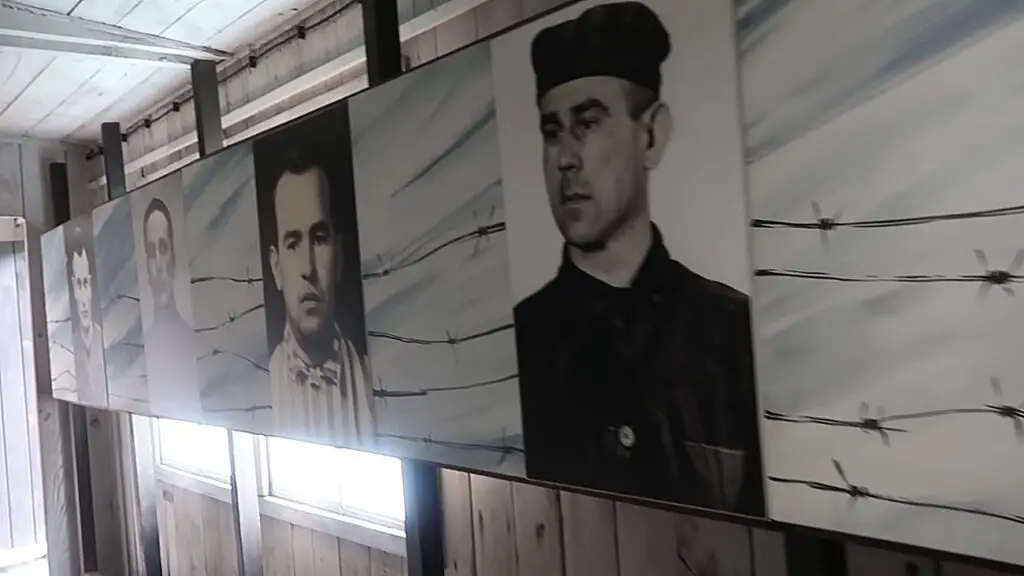
Over 120,000 people are believed to have been sent to this camp, with around 65,000 of these prisoners meeting their end here. This gives almost 2/3 of the camp population.
Treblinka Concentration Camp
Let’s talk about Treblinka, the last of the three camps formed for Aktion Reinhard. It took several years and numerous processes to set up this camp. In mid-1941, the labor camp, Treblinka I, was established to exploit the Jewish and Polish population. With an area not exceeding 17 hectares, it was still pretty large.

Command and Structure of Treblinka
SS-Hauptsturmführer Theodor van Eupen led the camp. In early 1942, a second camp, designated for the mass extermination of Jews, was set up alongside Treblinka I. This entire space was tightly enclosed by barbed wire, trees, and an interior strip. Treblinka II spanned 24 hectares, and was split into three sections: residential, transshipment, and a zone for executing prisoners. There was also a railway siding for receiving new transports.
The Illusion of Normalcy
The siding was eventually designed to mimic a real railway platform, tricking new arrivals into believing the camp was a harmless place. After being prepared in the summer of 1942, Treblinka was ready for more prisoners. Prisoners were used to expand the camp, digging enormous pits for the corpses provided by Treblinka II’s gas chambers.

The Operations of Treblinka II
Originally there were three gas chambers, but ten more were added later. The first shipments of prisoners arrived on July 23, 1942, primarily from the Warsaw ghetto. Upon arrival, prisoners were segregated. The weak and ill were taken aside and shot, while others were led to the gas chambers. Some prisoners were assigned to work, like burying the dead and running the utility rooms.
Dismantling Treblinka
The Nazis started planning to dismantle the camp around mid-1943. By September 1943, all buildings were taken apart and destroyed. The land was plowed and sowed. Those who assisted in this process were sent to Sobibór and executed. The commandants of the camp included Irmfried Eberl, Franz Stangl, and Kurt Franz. The liquidation of the Treblinka I labor camp ended in July 1944.

The End of Treblinka
The camp was shut down before the Red Army reached these regions. Soviet soldiers entered the Treblinka I labor camp in July, by which time the camp had already been evacuated.
Counting the Victims
Despite Treblinka operating for just 14 months, the scale of the atrocities committed there is horrifying. German records estimate that over 710,920 people were killed at Treblinka. However, the actual number of victims could be even higher. It is assumed, however, that up to 920,000 people could have died here. Although the Germans tried to erase their horrifying crime, the discovery of human remains soon revealed the existence of the mass extermination camp in Treblinka.
Nazi Concentration Camps in Poland – The Unsettling Numbers
During World War II, the Nazis carried out an estimated 50,000 various crimes against the Polish nation. A total of 5877 camps, sub-camps, work units, branches, and ghettos were established in Poland. In most cases, these places turned into murder sites, often on a mass scale.
As many as 6,028,000 Polish citizens lost their lives during World War II, with only 644,000 being war casualties. But, it’s worth saying these figures don’t count the „silent victims” of the system. These were people who died in the immediate post-war period from injuries caused by Nazi activities.
Survival in Concentration Camp and Aftermath
Believe it or not, only 10% of prisoners survived the concentration camps. Among these survivors, only 5% lived for more than 20 years after liberation or regaining freedom.
Historians studying Sonderaktion Krakau can tell you a lot about this. They’ve seen how many university workers from Krakow lost their lives after liberation, deaths that were directly linked to their time in prison. The conditions in the German camps were catastrophic, and the harsh experiences forever warped the lives of those who faced the Nazi death machine.
The suffering of the Polish nation and other European nations enslaved by the Third Reich is a stark reminder. I believe it shows that the crimes of the German nation cannot be excused or justified in any way.
Concentration Camps Memorial Museums
Post-war years witnessed the rise of museums at the sites of Polish martyrdom. The Polish People’s Republic authorities took care of this initially, and this path was later continued and expanded in free Poland.
They’ve gathered large archives documenting German crimes and preserving the memory of the tragically deceased. Among these, the most frequented is likely the Museum in Oświęcim-Birkenau, the site of the most heinous torture and mass genocide during the war.
The Pursuit of Justice
It’s worth noting that the punishment of those guilty of these atrocities played a crucial role in the post-war history of German crimes. In 1950, the Commission investigating these crimes took on the name of the Main Commission for the Investigation of Nazi Crimes in Poland. They undertook many investigations, documented numerous murders, and transferred many case files to Austria or West Germany for local law enforcement to handle.
However, the punishment often didn’t fit the crime. Less than 10% of those proven guilty faced any form of punishment. Directly after the war, there were trials for those particularly responsible for the Nazi war and extermination machine.

The trial of Rudolf Höss, commandant of the Auschwitz camp, held significant importance for the Polish justice system. Höss was sentenced to death and the sentence was executed by hanging. Yet, it was a mere drop in the ocean of blood spilled in the name of the National Socialist ideology.
Trials in Nuremberg
The International Military Tribunal in Nuremberg also led to the partial punishment of the guilty. But even here, we can’t talk about full justice. In the early post-war years, a large number of Nazis were judged in Poland thanks to enforced extradition. Over time, this practice faded, particularly noticeable in the American occupation zone of Germany, where many common executioners of the Nazi war machine found shelter.
Summary
Today, we can’t clearly explain why „people prepared this fate for people”, or what caused their brutal behavior. What we do know is that despite our efforts, despite hundreds of documents and files, justice was largely never served. The majority of the victims remain nameless forever, resting in mass graves overlooked by the very German criminals responsible for their fate.
References:
- https://warhist.pl/polska/niemieckie-obozy-koncentracyjne/
- https://przystanekhistoria.pl/pa2/tematy/obozy-koncentracyjne/61575,Niemieckie-obozy-na-ziemiach-polskich-1939-1945.html
- https://truthaboutcamps.eu/th/niemieckie-obozy/15475,Niemieckie-obozy-na-ziemiach-okupowanej-Polski-w-latach-19391945.html#:~:text=Najwi%C4%99kszym%20obozem%20zag%C5%82ady%20na%20ziemiach,funkcjonariuszy%20gestapo%20oraz%20Sonderkommando%20SS.

